
UME (Universal Machine Emulator) combines the features of MAME and MESS into a single multi-purpose emulator. The project represents a natural course of development for the emulators which already share large amounts of code and is part of an ongoing effort to unify development efforts and provide a single emulation platform for users and developers alike.
As an end user this means that the software provided here is not only capable of emulating arcade machines like the baseline versions of MAME, but in addition can emulate a large number of home computers and consoles from across the world using the very same code, developed by the very same team of developers.
UME binaries (Windows)
0.148u5 Windows binaries (32-bit and 64-bit) (Self Extracting 7-zip) (all MAME / MESS tools included, both 32-bit and 64-bit versions in tool32/tools64)
The source is identical to that found on mamedev.org (SVN revision SVN 22981 / 0.148u5)
Non-UME binaries (Windows)
In addition to providing the UME binaries I’ve also included a package with the individual legacy MAME/MESS executables here, personally I prefer the everything under one exe UME solution but I’ve noticed it’s not always easy to find binaries of the regular u builds with them not being offered from the official site so this is my attempt to address that.
Latest U release binaries for UME, as well as MAME & MESS can also always be found on the page linked in the box on the left
These binaries are coming from Mamedev (me) so are as official as you’re going to get for a u update.
Please note, if you want to compile a linux build you should check the source out from the official SVN instead of downloading it, there is an issue with some source files and line-endings whereby the linux python scripts don’t agree with the Windows style line endings you get on the downloaded source. Details of the SVN server are still on mamedev.org
Experimental Visual Studio compiled binaries (Windows)
I’ve also compiled some builds of MAME/MESS/UME 0.148u5 with the Visual Studio 2012 (update 2) compiler, using the August 2007 Direct X SDK (everything after that drops some files MAME needs) and set to use the Windows XP compatible platform SDK (see here, otherwise VS2012 exes won’t run on XP)
UME or Mame & Mess
These are experimental builds due to some level of interest expressed in having them for comparisons, don’t report any bugs with them please (some things are known not to work when compiled with Visual Studio, eg. the PC emulation used by Fruit Land in u5)
What’s New
You can read the various whatsnew files on mamedev.org
From MAME, From MESS
Points of Interest
Coming Soon.. (in progress)
There are a couple of interesting additions in 0.148u5 across both the MAME and MESS parts of the projects, so I’m going to start by looking at some of the arcade stuff
R.Belmont has probably already covered everything you need to know about this one, but one of the more curious additions in u5 is a game called ‘Fruit Land’. It bears no copyright display, so we don’t know when it’s was released in arcade from exactly, but it runs on a 486 PC and is a hacked up version of a PC game from Messoft (nothing to do with Mess the emulator) Note, this WON’T work with the Visual Studio compiled builds above, also performance in-game is around 30% speed on a my C2D (due to the demands of the x86 emulation) and there is no sound, so for now it remains something curious / interesting rather than something you’re going to want to run.
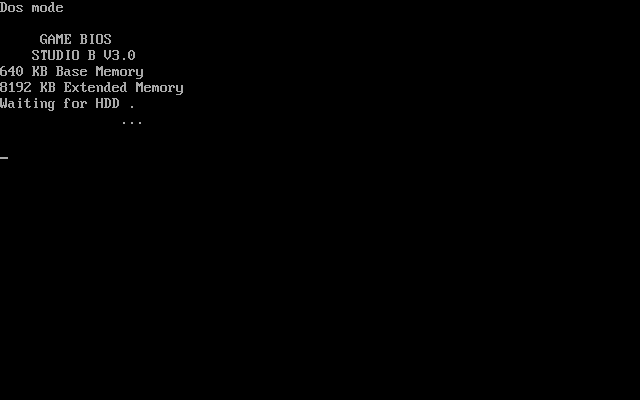

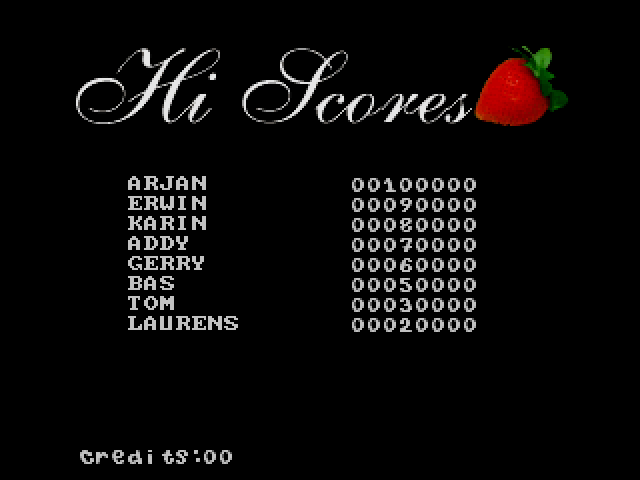

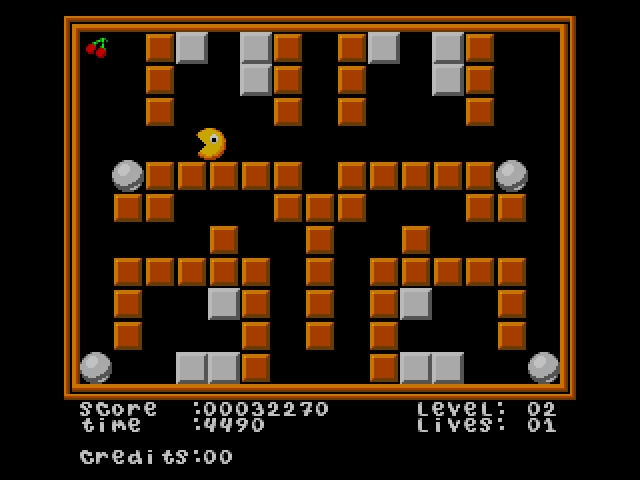
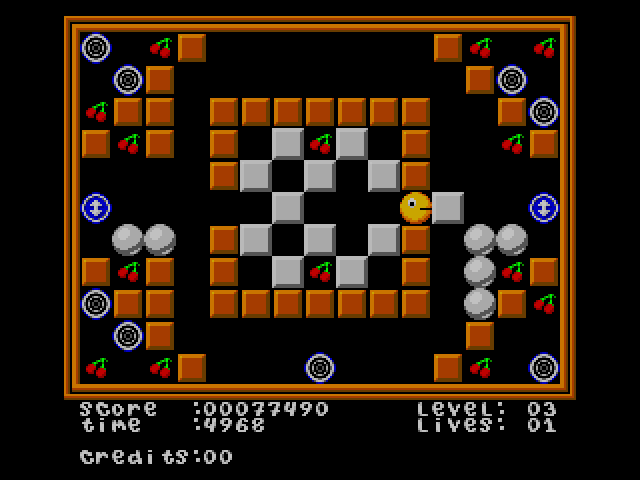
(Fruit Land is an obscure arcade version/hack of an equally obscure PC game)
Stunt Air, as featured in the update below is also included in a playable state, although hap has been doing some work on improving various aspects of it since the release, so you might want to wait until u6 / 0.149 for a better experience (and maybe by then we’ll have measurements from the PCB to make it sound better etc. too) Minimal pictures of this one because you can see more below.
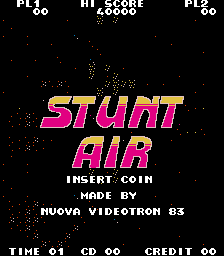
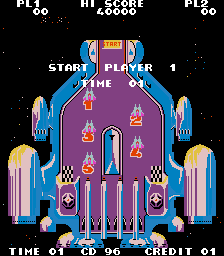
(The progress shown below on Stunt Air is included in 0.148u5)
The Konami GX game “Taisen Puzzle-dama” is often mis-sold on eBay as ‘Crazy Cross’ (in part because it’s the name people know it by from the PSX port) Screenshots of an actual Crazy Cross version have been seen, but it’s possible that version was only released in Korea (and possibly other parts of Asia) like the English language Sexy Parodius. It was thought that maybe that version had finally been found, however what was found instead was a game called ‘Lets Attack Crazy Cross’, which is possibly some kind of sequel. More interesting is that this game isn’t on GX at all either, it’s on one of Konami’s Playstation based platforms. Unfortunately this means it’s a CD based game, and Mamedev still have no good established dumping standard for CDs (I’ve tried making links between the DU and groups like Trurip) The game does appear to work however and as you’d expect seems like a sequel of sorts to the original Crazy Cross game. I guess it was a relatively quick port from a Playstation console release codebase because it doesn’t even flash ‘Insert Coin’ at you during the title screen of attract mode.
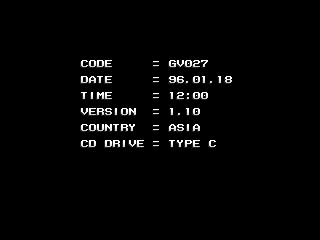
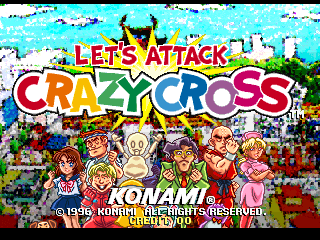
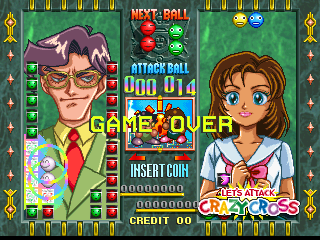
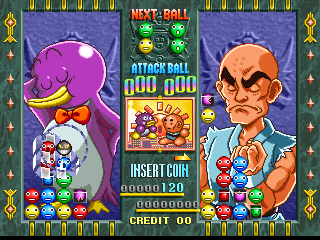
(Let’s Attack Crazy Cross runs on Playstation based hardware)
Roberto Fresca has chipped in with his usual work on Video Gambling games, with the highlight of the bunch being the Crystal Colours one, as featured on his page. You know what most of these involve already, so the only real interesting details are the technical ones and he discussed those in great detail already. (his site seems to have no way to permalink to updates so you might have to scroll a bit if he updates again)
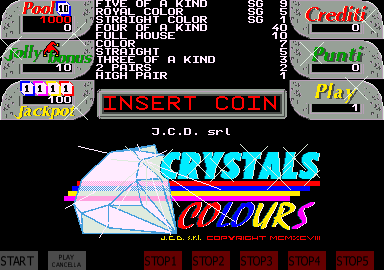
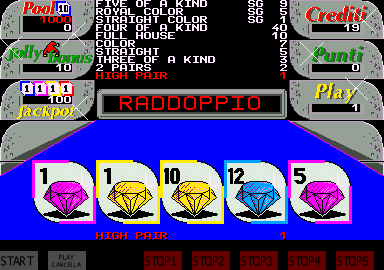
(Crystal Colours is one of a number of Video Gamblers Robbie contributed the emulation for in 0.148u5)
Moving away from the new additions to feature improvements, Mooglyguy came into some time recently and resumed work on the HLSL improvements, including the code for the vector games such as Asteroids. Part of this work was adding ‘bloom’ effects, as made popular by the AAE emulator. The image below shows these effects being used on Asteroids (possibly turned up a bit high) I haven’t found a way to make the bullets glow yet tho, I’m not sure if that isn’t possible yet, or if it needs more expert knowledge of the settings. It should be noted that as part of this work the D3D code was cleaned up, and support for Direct 3D 8 dropped, so you’ll need 9 or higher to use D3D modes in MAME from this point forward.
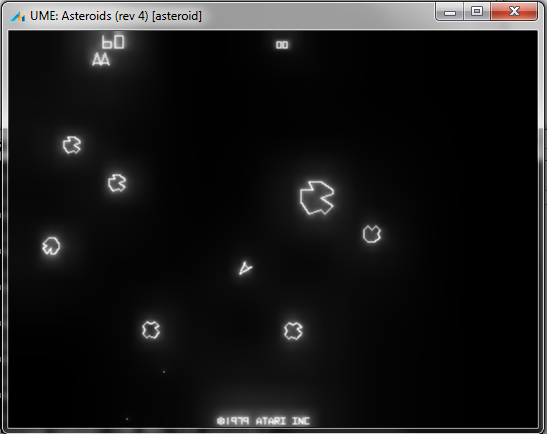
(0.148u5 gives preliminary HLSL support for Vector games like Asteroids)
You can of course also apply the new effect to raster games, although for anything other than the classics with mostly black backgrounds and basic graphics it tends to just wash out the image at default levels, the following screenshots are set to silly ;-)
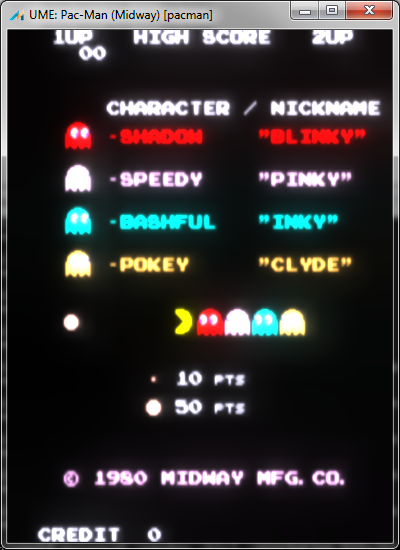
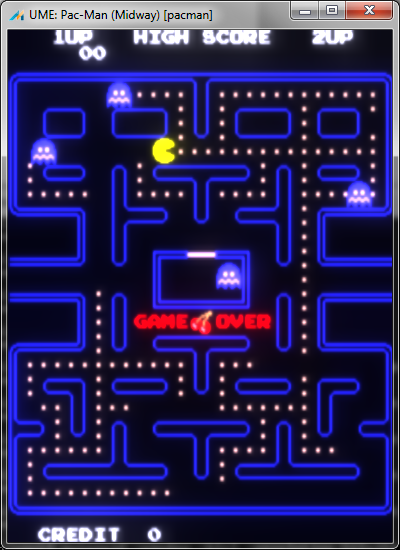
(it can also be used with regular raster games if that takes your fancy..)
It’s not often I mention clones in these write-ups but given I did an entire article about the Spanish clones a few days ago I think it’s fair that I mention they’ve all been included in u5. In addition to the ones featured there a few more were dumped, including several versions licensed to Tecfri. MotoTour is the Tecfri release of Traverse USA / MotoRace, and while in reality the modifications are tiny it’s still good to have the version of the game that was distributed in Spain supported. Ricky2001 is to thank for that one :-) All these Spanish clones so far have been unearthed and dumped by members of the AUMAP (Asociación de Usuarios de Máquinas Arcade y Pinballs) site / forums, and the Spanish release of Bagman (licensed to Itisa) is no exception, and is another nice find. The relationship between Itisa and Valadon is an interesting one, and thanks to information provided by the forum members it was also noted that we’re currently missing the original Spanish release of Botanic, with the one we have currently supported being a French version released by Valadon under license from Itisa, previously we thought it was a Valadon game. It seems Valadon and Itisa licensed each others games, and the production of the PCB type they use.
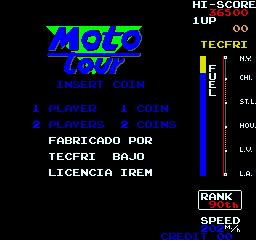
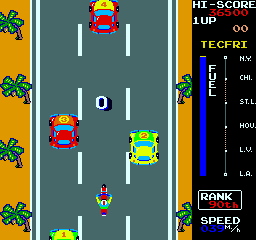
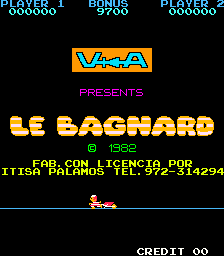
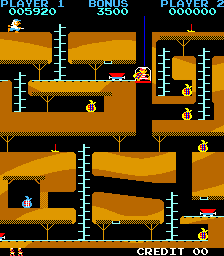
(more clones were dumped by the users of Spanish site AUMAP)
ANY has also been busy dumping various bootlegs, and while quite a few of his sets appear to have bad roms, or be uncertain / have such tiny changes it could indicate they’ve got bad there are a number of interesting things amongst the clones he dumped as well. Datsu were a common bootlegger of Sega games back in the 90s, so an Altered Beast set with their name on it was a nice find, although like all bootlegs it’s hard to know if it’s the original bootleg, or a bootleg of a bootleg.. Either way the mods are extensive enough that it really doesn’t work well in MAME yet (like so many of the System 16 bootlegs) f205v dumped a bootleg of Bomb Jack Twin called Atom which finds itself in a similar position, a reworked (vastly inferior) sound system, and different sprite hardware mean that it currently sits as a non-working addition. Sometimes emulating bootlegs is just as much work as emulating the original games in the first place although it can be a good place to start for new developers…
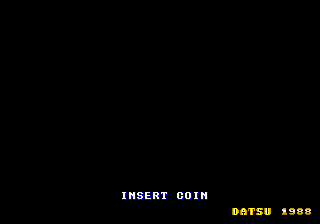
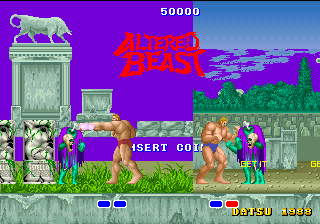

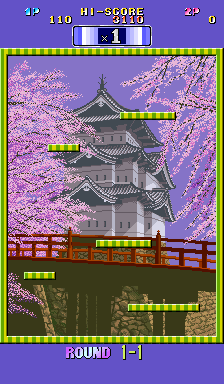
(some bootlegs have significantly reworked hardware and are a lot of effort to get working, these two were added but still need work)
The new non-working list for 0.148u5 also has a few interesting entries. Sea Battle is one of the few remaining unemulated Zaccaria originals, and until recently the only dump was from a board that had been stripped for parts and was missing the program ROMs. ANY recently dumped another board of it, complete with said program roms, so a skeleton driver with the various graphic decodes has been added. Interestingly the new board is very different to the older one, so it’s possible it was a bootleg (the new one is much closer to the schematics) although we’ll probably never know unless another one of those turned up. For now you can see the decoded graphics in the F4 viewer, although no emulation work has been done yet. I might take a look at it if nobody else does, although the CPU isn’t one I’m overly familiar with.
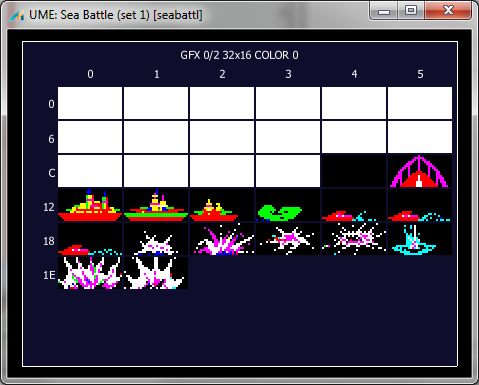
(GFX decoded from Sea Battle by Zaccaraia)
One addition in that not-working list that has turned out to be rather controversial with the other developers is the Midcoin Jukebox. Personally I wasn’t expecting it to be a big deal, it’s a coin operated device, from an arcade game manufacturer (who owned arcades) that you might find in a similar place to arcade games themselves. To me that makes it MAME criteria, to others it’s apparently MESS criteria. I thought we’d established that the dividing line was if something accepts coins or not, but apparently not. The solution to this problem is of course obvious, just make MAME all inclusive and stop having any silly dividing lines, but I really didn’t want to have to bring that topic up again. It’s not working yet, obviously, and only sports a primitive segment based display from what I can see, but I think it makes an interesting, albeit rather pointless emulation target. I think it’s great to see such things supported anyway, seeing MAME as an open minded project can only be a good thing, and will hopefully allow people to realize that there are many things we can emulate, and are interested in emulating or letting them emulate within our framework / project!
Another in the non-working list is Time Fighter. I’ve covered Brazilian clones of games before, mentioning how we’ve seen several that have been reprogrammed from scratch rather than being direct bootlegs (Fantastic, Kong etc.) and it looks like Time Fighter is another to add to that list. It’s a copy of Time Pilot, but it’s been written to work with (heavily) modified Galaxian hardware. It doesn’t work yet (missing bullets amongst other things) but it’s another fascinating example of just how far bootleggers were willing to go to be able to sell games on the hardware they had available, which presumably at the time these conversions were done was very limited.




(hap did some preliminary work on this rewritten Brazilian version of Time Pilot called Time Fighter)
Now you might wonder why I’ve covered so many non-working things, but I think it’s important to represent work in progress as well, provide a glimpse of the future and show people what things are doing now, so that when they get worked on again in a few years people can look back and see the difference. It also shows how that by working on MAME / MESS we’re not only solving problems and closing cases but always creating new work for ourselves, and new avenues for contributions.
At a core level there have been some interesting improvements too, one of the things to take special note of is the Lua integration. Unlike Python, where we use the scripting capabilities provided by the language as part of the build process, Lua has been integrated into the actual codebase. From the point of view of a casual MAME user the reasons for this might not be immediately obvious, however the real target with such a system is the MESS side of the project where having a scripting language that executes in parallel with the emulation, and can be aware of various internal states will hopefully allow for the scripting of some install / boot processes, and when you’re dealing with some systems where the process is a lot more complex than simply turning the machine on this could prove to be a very useful feature in the long-run when it comes to regression testing, and boosting ease of use for some more complex systems.

(0.148u5 starts to provide integrated Lua support for scripting of boot sequences etc.)
Beyond that, smf has modernized a lot of sound cores, although there is still a long way to go before the legacy device system can be dropped entirely (many, many CPU cores still need converting, and they’re generally the trickiest of the bunch to do)
A couple more steps were taken towards treating Qsound as an emulated CPU were taken as well with the various Qsound based drivers now being set to load the internal ROM from the Qsound chips, work is still needed on the CPU core amongst other things before that gets enabled for actual use tho.
Moving onto the MESS side of things, one of the more important changes is improved Save State support for a number of popular systems including the NES, Gameboy, Lynx, Wonderswan and NeoGeo Pocket. That might not sound like a lot, but it’s something a lot of users have been requesting for a while, and if you’re accustomed to the standalone emulators it really is something you miss, or something that can leave a bad impression when it doesn’t work properly in MESS so it’s good to see improvements in that area.
The MAME changelog says that the Qsound rom was (finally) hooked up, does that mean the effect is now added to the sound of cps2 games? Or were they already accurate?
This is something that has been bugging me a little… but my only comparison are the console ports and soundtracks, which all sound a different compared to MAME.
No, the synthesis still isn’t working, this is simply one step closer.
The Sega Saturn ports of the Capcom fighters have emulated Qsound working in the MESS side however.
MSVC miscompiles the 386 core by screwing up the unaligned reads. That’s why Fruit Land doesn’t work.
What about the new chd improvements??
By the way, huffman coding will return to compressed CDs ????
Arbee: the Saturn ports of Capcom fighters just have prerecorded CD Audio (like the soundtrack CDs, as I mentioned). Last time I checked, they had no actual DSP effects done on hardware, even for titles that actually use the internal synth chip for music (Vampire Savior).
I think some of the Capcom games had DSP effects done in software, but Arbee is the sound guy so he will probably give the right answer when he passes here
“What about the new chd improvements??
By the way, huffman coding will return to compressed CDs ????”
haven’t got around to mentioning them yet. need to check them, the downside is that a lot of CHDs might need remaking from scratch of course.
huffman compression mode won’t return to CDs by default. In testing almost 1TB of images there can only be one or two tiny blocks where it was selected anyway, the modes we have are better, the huffman thing was designed for the Laserdiscs, and that’s the only place it really has benefits.
also, I would not do any update to chds until we get ccd support as well… but just my 2c
well given how few images out there are CCD (basically just trurip, and some random dumps) then there is plenty we can do already.
CCD will invoke an entire new bedding in process too ;-)
For PSX you only really need trurip for the protected subcode discs. AFAIK the redump stuff is offset-corrected for discs with audio tracks (or at least it appears to be from the ones I’ve looked at) so that’s the only major benefit to it there.
zyrobs: That’s surprising, as there was a fully capable Qsound encoder that ran on the SCSP’s DSP (for free as far as game framerates are concerned). I know at least some EA sports games used it, plus the Qsound developer demo disc that’s in the softlist.
I should note that Qsound applied more to the sound fx than the music on those games, so even if the BGM is CDDA there can still be Qsound on the actual sounds.
@Haze: could you mention in your post that I’m looking for any report of save states not working in NES, SNES, MegaDrive, GameBoy, GameBoy Color, Neo Geo Pocket, Neo Geo Pocket Color, Lynx, Wonderswan and Wonderswan Color? I’d really love to mark all of these as supporting save state before next release…
ok, I’ll mention that when I get back to updating things, currently looking at a few bits for the Spanish guys instead, and obviously doing a bit of work takes priority over the update ;-)
“R.Belmont has probably already covered everything you need to know about this one” you mean him leaving the project? (http://rbelmont.mameworld.info/?p=815) That kind of sucks.
It’s an act. If you saw half the insults being thrown my way earlier you’d probably be glad to see the back of several of them.
Anybody who actually cares about the project will continue contributing even through all that tho, so if they think they can get rid of me they’re wrong. Unfortunately it means that their hissy fits are more effective because everybody knows I’ll continue to contribute and give my opinion on matters regardless of how much I get walked all over. It’s no secret that a number of them would like to see the back of me still, and will put words into my mouth, tell me that my intentions are not my intentions etc. and turn actual proper discussions on the mailing list into simple trolling of what I’m saying to avoid the discussion.
and yes, all this kicked off because of that Coin operated arcade jukebox, trying to claim I added it to cause controversy when I added it because it’s a coin operated arcade machine and I thought we’d established that arcade machines that take coins belong in MAME, so that’s where I added it (had it been a home jukebox, it would have gone in MESS, naturally)
I’ve never seen a jukebox in an arcade though…
While I understand that it accepts coins and was in an arcade, I don’t understand why it wouldn’t be added to MESS instead. How many things have been added to MAME that aren’t related to games before? The only things I can think of are test ROMs for certain games and firmware upgrades for systems that were for games. How many people have gone to an arcade to listen to a jukebox? I personally don’t know any. Mind you, it ultimately doesn’t matter to me what gets added where because I’ve already removed 24cdjuke and thousands of other entries from mame.lst for my own build. I’m just curious.
There is no offense intended, in case you are wondering. I appreciate the effort of every single developer for MAME and MESS. I wish you guys got along better though. :)
Just for the record: back in the old days (yeah, right after the war) there were some jukeboxes in arcades. At least in Italy. Pink Floyd’s “The wall” was usually among the top 5 and “Run to the hills” rocked like anything.
Yeah there certainly were commercial jukeboxes for arcades, or at least locations with a large number of arcade games (large bars etc.)
I simply thought we’d established that commercial use machines for such environments were MAME material, because they’re ‘arcade machines’ and take coins. Personally I’ve never seen this ‘Fruit Land’ thing in an arcade, and probably never will (I wonder if anybody did or if it was just some experimental thing somebody did for a one-off) but it’s never really been about popularity :-p
This thing was made by Midcoin (of Italy, so likely even the ones you saw..) and probably used in their own arcades, the same company who made several arcade games.. Really surprised me that people found it controversial, even Atari explored alternative entertainment options when they inserted a paint program mode rather than a game in I Robot.
Going even one steo further, I remember a black jack machine. Dunno whether it worked like a fruit machine with a screen or wether it had “real” light but you could insert coins used for the arcade machines (gettoni to be precise) and win some more or loose. It had an algorithm that would spit out a decent handful of gettoni once in a while, especially after people kept losing for several rounds, so if you watched this thing and got your timing right the odds were definitly in your favour.
Probably nothing that could ever be emulated in a narrower sense but interesting nonetheless. And this was several years before the whole fruit machine mess spread.
Damn it, I meant step, not steo.
sounds like the most primitive form of the same thing, yes, could have been entirely logic tho, without a CPU (although there is just as much chance there was a CPU I guess)
if anybody finds one then they should at least check, while utterly pointless if it is CPU based we could emulate it ;-)
(and of course the interesting thing about that would be not to use it, but to study the code and the algorithm it used)
could easily have worked more like the mechanical part of a coin pusher inside tho
I try to remember when I saw that one… was probably between 1988 and 1992 gutsfeeling says. In case that helps ;-).
Yeah, the first one was apparently made around 88, although apparently there are 1992 strings in this ROM, so that’s bang on for the time period ;-)
In my hometown there is still at least two places with ‘modern’ jukeboxes that accept coins and display the music videos on TVs as well. I’m not sure if they qualify at all here, but if they do I’d be calling them fit for MAME more than for MESS considering there’s no external option for sticking in different discs like a console or plain computer (which I normally associate with MESS more).
Surprised to see R.B ‘leave’ per say, although maybe it’s just me not being in the know regarding all that drama.
I’m interested about the Raiden Fighters JET clone that has a sound test. Given how much of a piece of shit Raiden Legacy for PC is (I own the iOS port legally, PC port not-so-legally :P) I’m curious about trying to do what DotEmu did and make a ThunderMAME-style hack for the Seibu SPI games (since the sample-based music is really the only good thing offered by Raiden Legacy), and having a sound test for JET could be handy for testing. Had a hand in modernising the ThunderMAME hacks for Shmupmame v4.2 so I might have a inkling of a chance at getting it to work. :P
Reading about Fruit Land, I wonder how much the original PC version and the emulated adaptation version differ.
The original source is downloadable at the MesSoft site, http://www.geocities.ws/messoft/Games/Fruitland/fruit.html.
So I was thinking if the difference is very small and the adaptation can be generated from the original version, could it be distributed at http://www.mamedev.org/roms/ if permission is made by the original author?
The problem could be the PC bios, which no doubt somebody holds a copyright on ;-)
It looks like MAME has lost another talented developer due to the many pathetic jokes on that team and forum. R.Belmont has just quit because of the drama. He said, “Longtime MAMEdev observers know from whom all drama flows, and the team tacitly chose him over me.” Who specifically is he referring to regarding the person whom all drama flows from?
http://www.mameworld.info/ubbthreads/showflat.php?Cat=&Number=309216&page=0&view=collapsed&sb=5&o=&vc=1
First they lost Haze and now it’s R.Belmont. When are they going to learn and look themselves in the mirror and realize that they are pathetic jokes who sit around fondling each other in their own clique. They are their own worse enemy as they push away anyone who doesn’t blow them and their high school clique.
The gameplay itself is the same, but the arcade version has custom hardware for the JAMMA I/O, adds sound, and tracks coinage. It’s not a trivial changeset.
The license situation on the game itself is a bit murky, and then throw in the BIOS and the copy of Italian language MS-DOS 6.22 that’s on the CHD and it gets much, much worse with respect to making it a “free rom”.
Thanks to both of you for clearing this up.
This peaked my interest a bit though, are bios and OS always lumped together with the game when creating dumps of arcades? On one hand it preserves the machine entirely, but on the other hand it could easily be a lot of duplicate data, such as when the same OS is used for different games.
I guess the MESS side is easier where media is dumped instead of machines.
MAME would be a crappy preservation project if developers could replace major software components of each game.
Would the preservation be worse if for instance
mame fruitland
would automatically load the right bios and os
and
mame fruitland -bios coreboot -os msdos622en
was allowed with a warning?
ANY thinks it’s likely a stealth poker game fwiw, so a certain sequence of keypresses (or a switch somewhere, not hooked up) would switch it to a poker game.
That type of thing (especially with remote switches for when the police arrived) were common in certain places, including Italy I think ;-)
Common enough that a major manufacturer (Subsino) made one (X-Plan) and even boasted about said feature on the flyer!
Mbit: Yes, it would be worse. MAME runs what shipped on the original JAMMA board, period. Just because it’s a PC and it’s easier to do so doesn’t give MAME license to modify the game. That path leads inexorably to “mame sf2 -nude”.
Haze: I wouldn’t be surprised at all if it was stealth poker, but nobody (including ANY) has found the magic switch yet. Might be worthwhile comparing the graphics data file to the original game’s though.
Arbee:
My mistake, I was thinking about MAME as an emulator of hardware for one to freely run software on. Reading up a bit, I realize it is an emulator of hardware locked to specific software.
Haze:
I’ve never heard of stealth games before, thanks for letting me know about this!
Yeah baseline MAME is kinda restrictive like that.
We emulate hardware as it shipped, so with arcade boards that’s typically a single non-changeable game. The idea is to document that.
If you take UME/MESS you have home systems which are a lot more flexible, where you can run your own things, although we’re not DoxBox so any PC emulation is still going to need a Bios and OS of some kind installed. I imagine the PC version of the game could be run in the at486 driver tho (might have to do some source mods for CPU speeds and the like mind you)
Still, the point of MAME isn’t to modify software so that we can distribute it, I’d already say the ‘Alien Arena’ set in MAME we have is a bit of a push, because we support a set specifically with no sound roms because we were given permission to distribute the game, but the game then requires the original Defender / Stargate sound roms which clearly we can’t distribute.
Building up a feasible and attractive library of free software for the UME/MESS home systems is more viable than trying to provide MAME sets in most cases, even if there is the prerequisite of the user needing the system roms in many cases (so things can never be 100% free on those platforms, even if the actual software is but luckily that doesn’t apply to all platforms).
If you look at somewhere like GOG.com you’ll see gaps in their ability to offer things commercially for similar reasons btw, even if many of their releases use DoxBox to emulate an old PC there are a huge number of games that were released that require older versions of Windows and they simply can’t distribute them because they’d have to get a license for Windows and emulate that in addition to the games. You’d think maybe by now Microsoft would just declare those old versions free-for-all, but they’re not.
Arcade games can be a trainwreck when it comes to licensing, and this despite being based on an free / open source game is no exception at all, it’s an unofficial pirate / bootleg copy of the thing in the first place, and because they’re always treated by MAME as one-fixed unit you can’t really escape the bios / dos thing by distributing only the game part, and if some of the coin handling is hacked into the bios, that won’t work anyway ;-)
Who is R. Belmont referring to when he said, “Longtime MAMEdev observers know from whom all drama flows, and the team tacitly chose him over me.”?
Well, once again thanks for your responses. You make good technical points :)
Too bad that all this drama strikes again.
Here I am yet again with another report of sorts. There weren’t any major changes that interested me with this update (oh well!), so I’ll report some small bugs that I don’t know the origin of…
* First off, FM Towns works again.
* SNES, sailormn sailormnf and sailormr don’t have working controls for some reason.
* Megadriv, Madden98 stops with an infinite loop. Not control related, but similar to the infinite loop in Eternal Champions CD with 6-button controllers connected.
* And the really bad, X68000. The software list uses DIM files, but the emulator doesn’t support them (yes I know that DIM is only XDF+
header). That doesn’t really matter though as the system won’t boot from the floppy drives at all. Honestly, this system should be marked as not working. PSX is way further along.
X68K used to work better, the Softlist was added / updated because AFAIK Tosec don’t update their lists very often and it’s a system where you often see people posting obscure games on random forums, so it’s more important to list those.
I don’t know the MESS policy on non-working stuff, I thought it was that the status should reflect the current driver status (unlike MAME where something non-working due to a regression is treated as a bug rather than having the flag regress) but I could be wrong.
SNES, can’t comment, it’s a very fussy system and the MESS emulation definitely isn’t on Bsnes level, might be an interesting test case you mention.
Madden98 I can’t remember anything special about, maybe it’s just a bad backup RAM hookup for that game.
@Tim: Many of the x68000 disks I’ve included were very hard to find, and that’s why I added them: last tosec update for these was in 2006 and that is what most places offer but the ~100 new disks added to an unofficial tosec update in 2010 are only available in one single torrent and ignored by most websites, and a few new disks (including some interesting doujin shooters like R+R or Direct-X) were only available as sparse links in forums and hence at risk of getting lost if the filesharing website decided to delete them…
while we work on modernizing DIM format and fixing the bug about disk recognition, I suggest to find a MESS between 0.147 and 0.148 and just copy the xml over the hash/ directory of the old version.
You will then be able to play most games to some extent
p.s. About DIM vs XDF: notice that if the image is larger than 1.2M (or if it uses a different geometry) then you cannot convert it to XDF anymore and it’s the reason why I chose DIM over XDF in the list. :)
p.p.s. In case you haven’t seen it, I had answered to your comment about the megadrive xml list
When will be the normal gui interface.
@etabeta: Yes, I saw your other post and I was able to produce the majority of changed ROMs without too much effort. I’m still not certain how to make the u3s for those weird EA games. I guess I need a utility to split high and low bytes, but I haven’t been able to find one yet.
if you don’t fear command line, you can check the utility pack by Neil Corlett
http://www.neillcorlett.com/cmdpack/
in particular, byteshuf does what you need here :)
the ‘gui interface’ is not normal, it is part of MAMEUI, and it is dead old code with no future.
people should be using a real frontend like QMC2
I understand if you are busy but I would love to see this post and the May 2013 targets one completed.
Mame needs more like you, the personal touch, dedication and vision shown in your writings is second to nobody.
I wish you can keep it up for years to come. Mame is only growing under your leadership. Congratulations
Thanks for the kind words but I guess you mean UME because MAME isn’t ‘under my leadership’ and hasn’t been for quite a while and even then UME is only really just an alternative target in the official source these days.
I’ll try to get the articles completed over the next couple of days, really I’ve been tied with a number of distractions and not managed to get half of what I wanted to do with MAME done in the last few weeks, nevermind finish the writeups.
If you’re lucky there might even be a newly emulated game to show in the next week or so thanks to some of the Spanish guys (even if looks more or less like a reskinned version of an already emulated one)
@etabeta: Thanks, again! And no, I don’t fear the command line. This will do quite well.
Arcade games based on IBM-PC were too much. The difference of real PC game was it wants a quarter every 5 minutes.
Sangokushi 4 (Koei)
http://www.grb.or.kr/download/GameImage/1999/제1706호.jpg
I had seen lots of those types of games. It was a portent of zounds of PC-cafes in korea. (cross cable used for RTS duel)
Warcraft, C&C, Duke Nukem 3D and there were more DOS games before Starcraft.
But Prehistoric Adventure lools real PCB.
http://www.grb.or.kr/download/GameImage/2003/2003-P0030-2.jpg
well there’s a Hyperstone CPU pictured there, so unless it’s just the wrong PCB picture, then yes, that’s arcade hardware, not PC hardware at all.
some Korean bootlegs are based on PC games anyway, there is that Tetris game in MAME which is just the PC version on it’s own PCB using ROMs.
but yes, sticking a PC in a cabinet hooked up to a timer (or any other console) was common even outside of Korea. One of the regular Korean sellers on ebay had such extra hardware preinstalled for Genesis and SNES for sale recently, although wanted far more than it was possibley worth ;-)
I’m told even the EmuDX versions of games (high resolution ‘enhanced’ Pacman etc.) made it onto PC based arcade cabinets in some parts of the world ;-)
I don’t know if it’s of any interest, but since you worked on FLAC in MAME, I just wanted to say that FLAC 1.3.0 has been released.
The changes are not that big, but there are a number of convenience methods for libFLAC++ and build system fixes for autotools, MinGW, gcc, Sun Studio/Forte, Windows, FreeBSD, OpenBSD, etc.